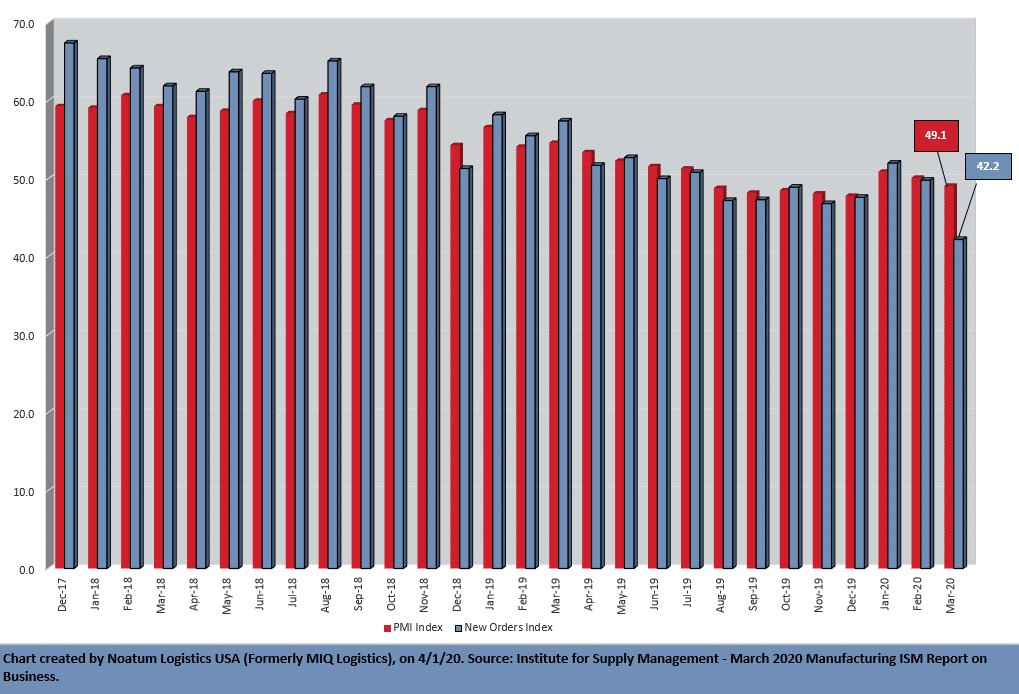Source: Institute for Supply Management – April 1, 2020 Release
Economic activity in the manufacturing sector contracted in March, and the overall economy grew for the 131st consecutive month, say the nation’s supply executives in the latest Manufacturing ISM® Report On Business®.

The report was issued today by Timothy R. Fiore, CPSM, C.P.M., Chair of the Institute for Supply Management® (ISM®) Manufacturing Business Survey Committee: “The March PMI® registered 49.1 percent, down 1 percentage point from the February reading of 50.1 percent. The New Orders Index registered 42.2 percent, a decrease of 7.6 percentage points from the February reading of 49.8 percent. The Production Index registered 47.7 percent, down 2.6 percentage points compared to the February reading of 50.3 percent. The Backlog of Orders Index registered 45.9 percent, a decrease of 4.4 percentage points compared to the February reading of 50.3 percent. The Employment Index registered 43.8 percent, a decrease of 3.1 percentage points from the February reading of 46.9 percent.
“The Supplier Deliveries Index registered 65 percent, up 7.7 percentage points from the February reading of 57.3 percent, and limited the decrease in the composite PMI®. The Supplier Deliveries Index is one of five equally weighted subindexes that directly factor into the PMI®, along with New Orders, Production, Employment and Inventories. Supplier Deliveries is the only ISM® Report On Business® index that is inversed — a reading of above 50 percent indicates slower deliveries, which is typical as the economy improves and customer demand increases. However, the high index reading in March was primarily a product of coronavirus-related supply problems.
“The Inventories Index registered 46.9 percent, 0.4 percentage point higher than the February reading of 46.5 percent. The Prices Index registered 37.4 percent, down 8.5 percentage points compared to the February reading of 45.9 percent. The New Export Orders Index registered 46.6 percent, a decrease of 4.6 percentage points compared to the February reading of 51.2 percent. The Imports Index registered 42.1 percent, a 0.5-percentage point decrease from the February reading of 42.6 percent.
“Comments from the panel were negative regarding the near-term outlook, with sentiment clearly impacted by the coronavirus (COVID-19) pandemic and energy market volatility. The PMI® returned to contraction territory, and with a negative trajectory. Demand slumped, with (1) the New Orders Index contracting at a strong level, in part pushed by new export order contraction, (2) the Customers’ Inventories Index remaining at ‘too low’ status, but increasing at a level considered a negative for future production, (3) the Backlog of Orders Index contracting again, at a moderate rate. Consumption (measured by the Production and Employment indexes) contributed negatively (a combined 5.7-percentage point decrease) to the PMI® calculation, with activity contracting at a faster rate. Inputs — expressed as supplier deliveries, inventories and imports — strengthened in March, due primarily to supplier delivery difficulties; inventory contraction stabilized. Despite imports contracting at strong rates due primarily to coronavirus impacts, inputs contributed positively to the PMI® calculation (the Imports Index does not directly factor into the PMI®). Prices continued to contract (and at a faster rate in March), supporting a negative outlook.
“The coronavirus pandemic and shocks in global energy markets have impacted all manufacturing sectors. Among the six big industry sectors, Food, Beverage & Tobacco Products remains strongest, followed by Chemical Products, which in addition to the pharmaceutical component, is a significant contributor to the Food, Beverage & Tobacco Products Industry and beneficiary of low energy and feedstock prices. Transportation Equipment and Petroleum & Coal Products are the weakest sectors. Sentiment regarding near-term growth this month is strongly negative, by a 2-to-1 ratio,” says Fiore.
Of the 18 manufacturing industries, the 10 that reported growth in March — listed in order — are: Printing & Related Support Activities; Food, Beverage & Tobacco Products; Apparel, Leather & Allied Products; Wood Products; Paper Products; Chemical Products; Computer & Electronic Products; Primary Metals; Miscellaneous Manufacturing; and Plastics & Rubber Products. The six industries reporting contraction in March, in order, are: Petroleum & Coal Products; Textile Mills; Transportation Equipment; Furniture & Related Products; Fabricated Metal Products; and Machinery.
Click here to access the entire release from the Institute for Supply Management website.
